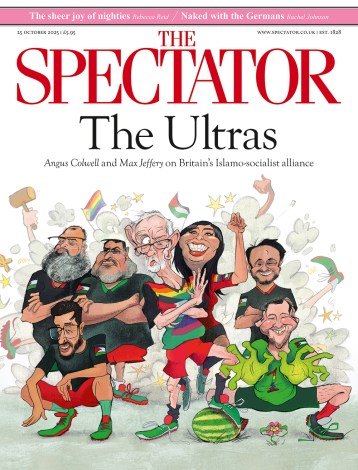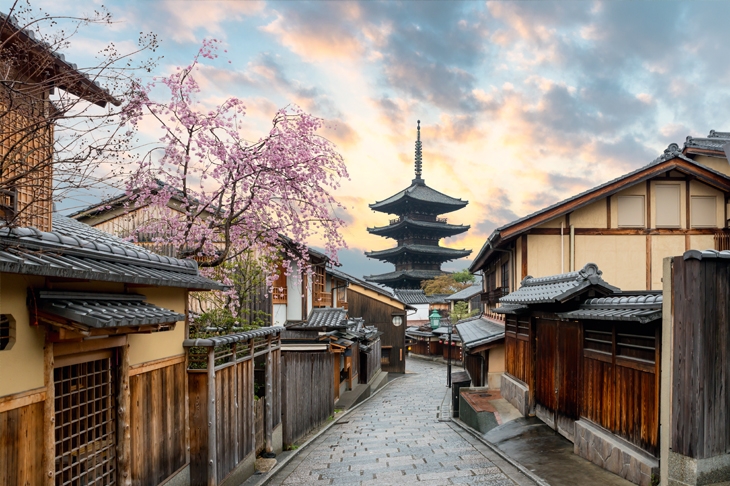‘Much of what I say may turn out not to be true.’ Hardly the ideal beginning to a guided tour. But Alex Kerr is not your typical tour guide, briskly selling a place to a time-pressed group via a few must-snap essentials — the glint of the sun off Kyoto’s Golden Temple and its still waters; the demure shuffle of geisha; winter rays radiating through a bamboo grove. Kerr is more the lone local you’re not entirely sure you should trust, sidling up and engaging you in conversation. Why do temples have gates without doors? Are they entrances — or exits? Ever thought about that? No? Come on, I’ll show you.
Kyoto is home turf for Alex Kerr, both as a long-time resident and as a fierce critic in previous books (Lost Japan; Dogs and Demons) of how modern and especially postwar policy-makers have trampled on Japan’s closely intertwined natural, aesthetic and spiritual inheritances — mile after mile of generic suburbia full of ‘boxy buildings’ and car parks; waterways and mountainsides coated in concrete; money splurged on roads to nowhere, alongside eyesore monuments and third-rate museums that planners rather idly expected would bring in tourist money (they mostly didn’t). Too much of the Asian art and architecture that Japan received, re-worked, and preserved across centuries has been lost in the process. ‘The treasure house at the end of the Silk Road that had been Japan,’ writes Kerr, ‘shrank down to the treasure chest of Kyoto.’
Another Kyoto is a celebration of what this city has helped Japan to hang on to, in architectural terms especially. But it is an indirect sort of celebration. This is not an introduction to Kyoto, more an initiation, bordering on a recruitment attempt, into the ways of seeing — of looking and questioning and pondering — that have deepened Kerr’s love of the place across decades. It is Kerr in conversation, recorded and edited by Kathy Arlyn Sokol, another local who regularly tours the city with him.
For anyone familiar with the experience of ‘temple fatigue’ — dutifully visiting a succession of similar-looking structures, armed with potted histories that leave you little the wiser — time in Kerr’s company will likely come as a relief. His approach is simple: begin with what you notice, and go from there. We start with gates, including a look at the fearsome, scowling guardian deities often found to left and right. ‘They don’t grimace in any old way,’ says Kerr. Some have open mouths, others are closed: the cosmic sounds of ‘Ah’ and ‘Un’, in and out, ‘the beginning and end of everything’. And these gates are often door-less because their purpose is symbolism rather than security: each set on the way up to the main temple is a ‘base camp’, personally transformative, ascending Mount Sumeru, the sacred peak, the centre of the Hindu and Buddhist universe.
We move on to walls — as much an exit from primal and everyday chaos as an entryway to the sacred — and from there to floors, plaques and screens. Kerr’s approach works best when readers are given new ways of framing their experience of all this. We discover the hierarchy of Shin (formal, higher), Gyo (semi-formal, middling), and So (informal, lower), running across and helping to connect calli-graphy, painting, humour, the positioning of objects, and the materials from which those objects are made. Bronze is shin, ceramics are gyo, bamboo or basketry are so. Kerr even offers a speculative leap to pop music and mobile-phone technology — Apple is shin, Samsung is gyo. His account of fusuma — Japan’s sliding doors — flows in a similar way, revealing the links between Asian migration patterns, climate, temple and domestic architecture, and the meanings of whiteness in Japan: the rich philosophical emptiness of off-white vs the vacuousness of the pristine, bleached variety found in hotel lobbies across Kyoto.
Kerr is so good at all this that some readers may find themselves wishing for broader, bottom-up coverage. Kyoto is helpfully introduced as a city where Chinese-style grid-patterned street layouts meet Japanese topography, with its ‘spatial flow of mountain-to-foothills-to-plains… the horseshoe of mountains to the north, west, and east has always been the realm of gods, demons, and ghosts’. And yet these wonderful orienting insights appear a few pages before the end of a book that lacks a map of the city. A smart complement to the text is offered in the form of illustrative sketches, the print equivalent of having your guide point their finger to a particular detail. But Another Kyoto is probably best enjoyed alongside an original Kyoto of some sort, whether through one of the introductory works that Kerr recommends or during a visit to Japan — currently experiencing a tourist boom on a scale so unexpected that some Kyotoites fear their home may go the way of Venice.
That said, Kerr’s way of questioning and puzzling through is hugely enjoyable in its own right, and pleasingly infectious. Add to that a fact-checker labouring for ‘hundreds of hours’ to verify the results — Kerr’s opener about ‘truth’ turns out to be quip rather than caution — and you have a book that can happily be thrust into the hands of any tourist, armchair or otherwise, who finds themselves squinting in the sunlight and wondering ‘What am I actually looking at here?’






Comments